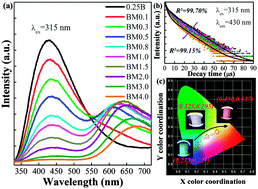Thermal quenching and energy transfer in novel Bi3+/Mn2+ co-doped white-emitting borosilicate glasses for UV LEDs
Abstract
The design of white-light luminescent materials with excellent thermal stability is still a challenge in the field of white-light emitting diode (W-LED) application. In this paper, a pair of novel Bi3+/Mn2+ ions co-doped into white-emitting borosilicate glasses were successfully prepared using a melt-quenching method. Their luminescence properties were evaluated using transmission spectra, photoluminescence excitation and emission spectra in the temperature range of 300–573 K, and lifetime decay curves. Upon excitation with a ultraviolet (UV) light, the co-doped glasses exhibit intense tunable emitting color between the blue and the orange-red region due to efficient energy transfer from Bi3+ to Mn2+, and a perfect white light emission is realized by appropriately adjusting the Mn2+ concentrations. Furthermore, the Bi3+ singly doped glass presents good thermal stability, showing about 72.3% of the observed room temperature (300 K) emission intensity at 423 K, while the thermal stability becomes lowered after Mn2+ ions are incorporated into the singly doped sample, attributed to serious thermal quenching from Mn2+. This work may help to better understand the interactions between Bi3+ and transition metal ions, and it might also be helpful in the future design of organic resin-free W-LEDs.


 Please wait while we load your content...
Please wait while we load your content...